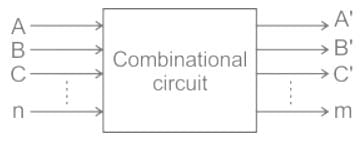Electronics and Communication Engineering (ECE) Exam > Electronics and Communication Engineering (ECE) Questions > Which of the following circuit has its output...
Start Learning for Free
Which of the following circuit has its output dependent only upon the present input?
- a)Analog Circuits
- b)Flip Flops
- c)Combinational Circuits
- d)Sequential Circuits
Correct answer is option 'C'. Can you explain this answer?
Verified Answer
Which of the following circuit has its output dependent only upon the ...
Combinational Logic circuits are circuits for which the present output depends only on the present input, i.e. there is no memory element to store the past output.
A combinational circuit can have ‘n’ number of inputs and ‘m’ number of outputs as shown:


Most Upvoted Answer
Which of the following circuit has its output dependent only upon the ...
Combinational Logic circuits are circuits for which the present output depends only on the present input, i.e. there is no memory element to store the past output.
A combinational circuit can have ‘n’ number of inputs and ‘m’ number of outputs as shown:


Free Test
FREE
| Start Free Test |
Community Answer
Which of the following circuit has its output dependent only upon the ...
Combinational Circuits:
Combinational circuits are a type of digital circuit where the output depends only on the present input. These circuits do not have any memory element, which means that the output is determined solely by the current input values. Combinational circuits are designed using logic gates, such as AND, OR, and NOT gates, which perform logical operations on the inputs to generate the output.
Sequential Circuits:
Sequential circuits, on the other hand, have memory elements in the form of flip-flops. These circuits have outputs that depend not only on the present input but also on the past inputs and the current state of the circuit. The output of a sequential circuit is a function of both the present input and the internal state of the circuit, which is determined by the previous inputs.
Flip Flops:
Flip flops are the basic building blocks of sequential circuits. They are bistable devices that can store a single bit of information. The output of a flip flop depends not only on the present input but also on the previous input and the current state of the flip flop. Flip flops are used to store and synchronize data in sequential circuits.
Analog Circuits:
Analog circuits are a type of circuit where the output is a continuous function of the input. These circuits use continuous signals to represent and process information. The output of an analog circuit depends on the present input as well as the previous input and the internal state of the circuit. Analog circuits are used in various applications such as amplifiers, filters, and oscillators.
Conclusion:
Among the given options, only combinatorial circuits have their output dependent only upon the present input. In combinatorial circuits, the output is a direct function of the input and does not depend on any previous inputs or internal states. Flip flops and sequential circuits have outputs that depend on both the present input and the previous inputs or internal states. Analog circuits, on the other hand, use continuous signals and have outputs that depend on both the present and previous inputs as well as the internal state of the circuit.
Combinational circuits are a type of digital circuit where the output depends only on the present input. These circuits do not have any memory element, which means that the output is determined solely by the current input values. Combinational circuits are designed using logic gates, such as AND, OR, and NOT gates, which perform logical operations on the inputs to generate the output.
Sequential Circuits:
Sequential circuits, on the other hand, have memory elements in the form of flip-flops. These circuits have outputs that depend not only on the present input but also on the past inputs and the current state of the circuit. The output of a sequential circuit is a function of both the present input and the internal state of the circuit, which is determined by the previous inputs.
Flip Flops:
Flip flops are the basic building blocks of sequential circuits. They are bistable devices that can store a single bit of information. The output of a flip flop depends not only on the present input but also on the previous input and the current state of the flip flop. Flip flops are used to store and synchronize data in sequential circuits.
Analog Circuits:
Analog circuits are a type of circuit where the output is a continuous function of the input. These circuits use continuous signals to represent and process information. The output of an analog circuit depends on the present input as well as the previous input and the internal state of the circuit. Analog circuits are used in various applications such as amplifiers, filters, and oscillators.
Conclusion:
Among the given options, only combinatorial circuits have their output dependent only upon the present input. In combinatorial circuits, the output is a direct function of the input and does not depend on any previous inputs or internal states. Flip flops and sequential circuits have outputs that depend on both the present input and the previous inputs or internal states. Analog circuits, on the other hand, use continuous signals and have outputs that depend on both the present and previous inputs as well as the internal state of the circuit.

|
Explore Courses for Electronics and Communication Engineering (ECE) exam
|

|
Similar Electronics and Communication Engineering (ECE) Doubts
Question Description
Which of the following circuit has its output dependent only upon the present input?a)Analog Circuitsb)Flip Flopsc)Combinational Circuitsd)Sequential CircuitsCorrect answer is option 'C'. Can you explain this answer? for Electronics and Communication Engineering (ECE) 2025 is part of Electronics and Communication Engineering (ECE) preparation. The Question and answers have been prepared according to the Electronics and Communication Engineering (ECE) exam syllabus. Information about Which of the following circuit has its output dependent only upon the present input?a)Analog Circuitsb)Flip Flopsc)Combinational Circuitsd)Sequential CircuitsCorrect answer is option 'C'. Can you explain this answer? covers all topics & solutions for Electronics and Communication Engineering (ECE) 2025 Exam. Find important definitions, questions, meanings, examples, exercises and tests below for Which of the following circuit has its output dependent only upon the present input?a)Analog Circuitsb)Flip Flopsc)Combinational Circuitsd)Sequential CircuitsCorrect answer is option 'C'. Can you explain this answer?.
Which of the following circuit has its output dependent only upon the present input?a)Analog Circuitsb)Flip Flopsc)Combinational Circuitsd)Sequential CircuitsCorrect answer is option 'C'. Can you explain this answer? for Electronics and Communication Engineering (ECE) 2025 is part of Electronics and Communication Engineering (ECE) preparation. The Question and answers have been prepared according to the Electronics and Communication Engineering (ECE) exam syllabus. Information about Which of the following circuit has its output dependent only upon the present input?a)Analog Circuitsb)Flip Flopsc)Combinational Circuitsd)Sequential CircuitsCorrect answer is option 'C'. Can you explain this answer? covers all topics & solutions for Electronics and Communication Engineering (ECE) 2025 Exam. Find important definitions, questions, meanings, examples, exercises and tests below for Which of the following circuit has its output dependent only upon the present input?a)Analog Circuitsb)Flip Flopsc)Combinational Circuitsd)Sequential CircuitsCorrect answer is option 'C'. Can you explain this answer?.
Solutions for Which of the following circuit has its output dependent only upon the present input?a)Analog Circuitsb)Flip Flopsc)Combinational Circuitsd)Sequential CircuitsCorrect answer is option 'C'. Can you explain this answer? in English & in Hindi are available as part of our courses for Electronics and Communication Engineering (ECE).
Download more important topics, notes, lectures and mock test series for Electronics and Communication Engineering (ECE) Exam by signing up for free.
Here you can find the meaning of Which of the following circuit has its output dependent only upon the present input?a)Analog Circuitsb)Flip Flopsc)Combinational Circuitsd)Sequential CircuitsCorrect answer is option 'C'. Can you explain this answer? defined & explained in the simplest way possible. Besides giving the explanation of
Which of the following circuit has its output dependent only upon the present input?a)Analog Circuitsb)Flip Flopsc)Combinational Circuitsd)Sequential CircuitsCorrect answer is option 'C'. Can you explain this answer?, a detailed solution for Which of the following circuit has its output dependent only upon the present input?a)Analog Circuitsb)Flip Flopsc)Combinational Circuitsd)Sequential CircuitsCorrect answer is option 'C'. Can you explain this answer? has been provided alongside types of Which of the following circuit has its output dependent only upon the present input?a)Analog Circuitsb)Flip Flopsc)Combinational Circuitsd)Sequential CircuitsCorrect answer is option 'C'. Can you explain this answer? theory, EduRev gives you an
ample number of questions to practice Which of the following circuit has its output dependent only upon the present input?a)Analog Circuitsb)Flip Flopsc)Combinational Circuitsd)Sequential CircuitsCorrect answer is option 'C'. Can you explain this answer? tests, examples and also practice Electronics and Communication Engineering (ECE) tests.

|
Explore Courses for Electronics and Communication Engineering (ECE) exam
|

|
Signup to solve all Doubts
Signup to see your scores go up within 7 days! Learn & Practice with 1000+ FREE Notes, Videos & Tests.


























